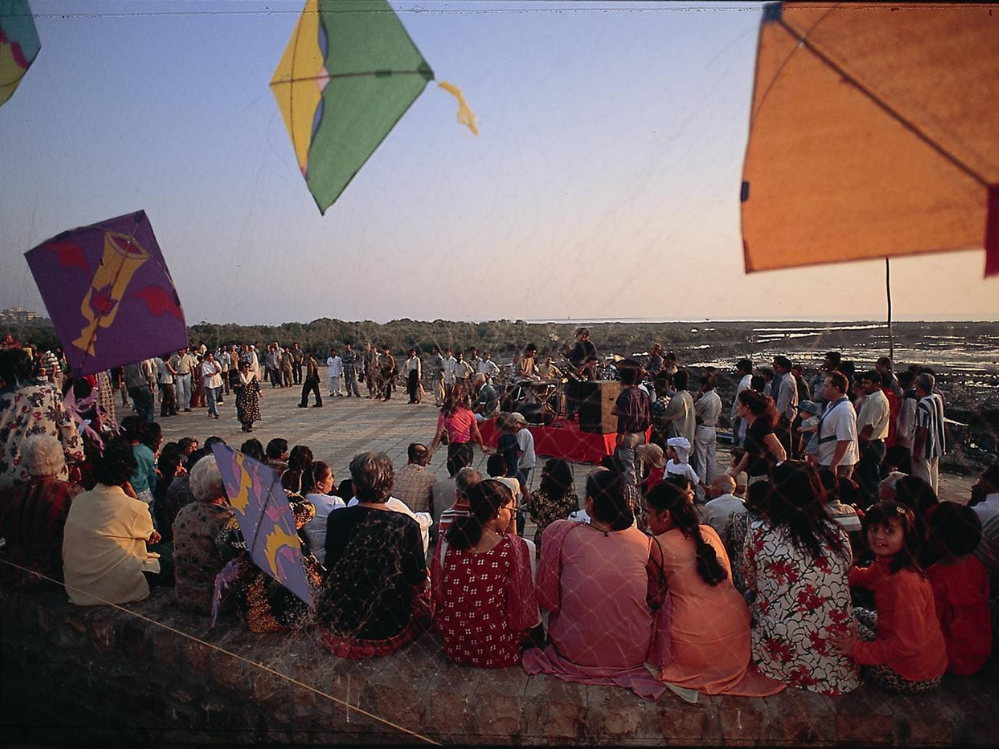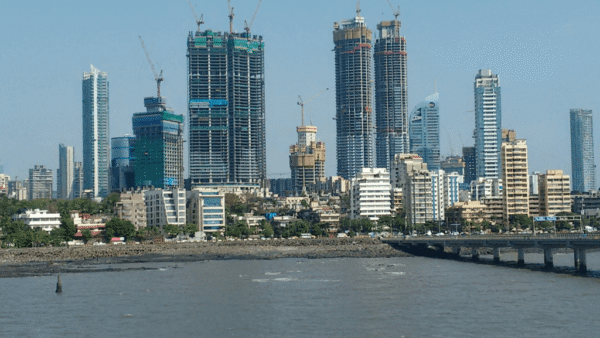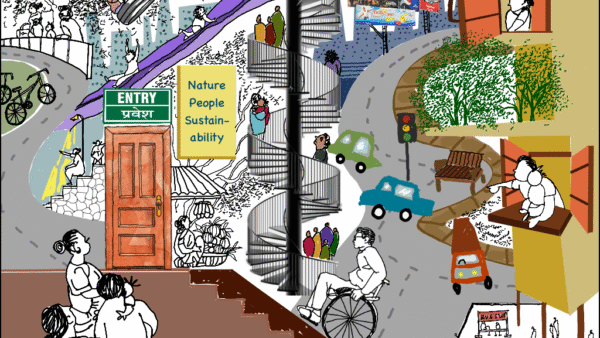It is not possible to build sustainable cities or adapt to the Climate Crisis without addressing the three critical inter-twined aspects: nature, people, and urban planning.
There is an intrinsic relationship between nature and people but it is often presented in the mainstream discourse as adversarial or binary, and the development of cities is equated with increasing construction activity and business turnover. The preferred approach is to create land through land-filling vast expanses of natural areas and over-powering the natural ecology of a city. This is done in the name of providing for people, yet this approach exacerbates the Climate Crisis, the brunt of which is borne by a vast majority of people, in fact the poorest of people in cities.
A possible way out of this is to break the binary between nature and people, and position both equally at the centre of urban planning so that nature and people – not economics or projects – determine how cities are planned and built. It is critical to rebuild the relationship between people and nature, which has been severed, to build livable and sustainable cities. This, in essence, is nature-led urban planning.
Exclusionary city planning
“How sad to think that nature speaks, and mankind doesn’t listen,” remarked the French writer Victor Hugo back in 1840.
Humankind, certainly the section that prioritises profits, has not listened. The neo-liberal age is committed to privatisation and free market-led development, in which cities are increasingly characterised by misutilisation of land, exclusionary city planning and deplorable state of the environment, in which vast numbers of people are discriminated and displaced. The planet seems to be hurtling towards a climate catastrophe. Writer-novelist Amitav Ghosh encapsulated this in the line “landscapes (or planets) come to be regarded as factories and nature is seen as subdued and cheap”.
In cities, rampant destruction of natural areas and biodiversity has significantly contributed to the Climate Crisis, threatening our health and very survival. Temperatures in the United States and Canada breached the record high of 40 degrees Celsius. In India, large cities such as Delhi, Mumbai, Bengaluru, Chennai, and Kolkata experienced heat waves, floods, and increased frequency of cyclonic winds. The catastrophic impact due to Climate Change can no longer be ignored, “urban development” which precipitates the impact cannot simply continue.
Most plans and projects not only ignore or undermine the needs of the majority of people, particularly the poor and the middle class, but also cause grievous injury to nature. As the Bengaluru Sustainability Forum points out, the COVID-19 pandemic laid bare the injustice and inequalities in cities: “Those disproportionately affected by the pandemic are also those who will suffer the most from the impacts and consequences of Climate Change. At the same time, responses to the pandemic have also indicated new emergent possibilities when there is shared sense of urgency and a wide-ranging socio-political commitment to decisive action.”
The recurring loss of life and property across the world due to climate catastrophe may be significantly higher than the losses due to the pandemic. According to an estimate of the World Bank, Climate Change could force more than 100 million people into extreme poverty by 2030, which in turn, would make them more vulnerable. United Nations’ reports attribute 3,00,000 deaths a year to Climate Change and project that increasingly severe heat waves, floods, storms, and forest fires will be responsible for as many as 500,000 deaths a year by 2030.
Urban development not business as usual
The Climate Crisis is the greatest humanitarian challenge that the world faces. Yet, the business of making cities continues as usual with a few mitigation measures taken.
It cannot be build-as-usual and build-more. We have to rebuild, for which we must re-envision cities and renew the relationship between nature and people based on the learnings from complex Climate Change phenomena. It is necessary to begin recognising and addressing the present hostile relationship between nature and people, and how this impacts the way people individually and collectively respond, or not respond, to nature in cities.
The city-making process has also polarised people on the lines of class, caste, religion, race, gender, colour and so on. The sharp divisions mean that more and more people are being denied access to rights and resources; exclusion, alienation, and violence define life in cities. These divisions, in both social and spatial terms, undermine the very idea of cities as free, just and liberating spaces.
In the words of writer Naomi Klein: “It is the depth and complexity of the crisis that is all pervasive and omnipresent, in which geo-politics, capitalism, climate change, and racial, ethnic, and religious divides interlock, each amplifying and accelerating the other.”
Whichever way one examines the issue, the twin axes of building relationships between nature and people, and adopting nature-led planning are inevitable.
Natural areas excluded from city planning
Rebuilding the relationship between nature and people towards more sustainable cities is an important mission and the basis of nature-led planning of cities.
People and nature are not exclusive to one another. Understanding their relationships, and adopting them into the planning process, are critical to our future. Sustainable cities are possible when we successfully and equally combine environmental and socio-economic dimensions in the planning and implementation.
In Mumbai, for example, urban planning treats one-third of the city’s area or the 140 square kilometres of its natural ecology – the incredible coastline, waterfronts, watercourses, and water bodies, mangroves, wetlands – as dumping grounds, physically and metaphorically. Indiscriminate land-filling of these areas for ill-conceived and short-term real estate gains, by land sharks and governmental agencies is rampant. Climate Change is never at the centre of planning.
Planners have turned their backs to Mumbai’s nullah network of over 300 kilometres. The nullahs were originally the natural watercourses of the estuary. Natural areas are hardly recognised or considered crucial in city-making, they do not even make it to the planning table. This results in the response to Climate Change being reduced to mitigation measures which are further limited to gas emissions and carbon footprint through technological and high capital investment measures. This approach ignores city planning and building decisions which destabilised the nature and its lifecycles to begin with.
This approach also ignores people’s role and participation in the decision-making process about cities, thereby positioning the state as all pervasive and powerful. This phenomenon of centralised structures of control over planning and implementation is significantly contributing to the formation of authoritarian and fascist regimes.
It is for these reasons that I propose nature-led planning as the basis for sustainable cities.
Nature and people: Building new relationships
Conservation and integration of natural areas in city planning must become the very basis of urban development. This should replace the existing emphasis in city planning of expanding land area and engineering higher real estate turnover, which has so far excluded natural areas from being even mapped in plans.
Not mapping them opens doors for them to be land-filled and included for ‘development’ in plans. For example, if Mumbai’s 140 square kilometres of natural areas were mapped in detail in the city’s plans, it would have been difficult to construct over them. The Development Plan of 1991 designated these as No-Development Zone (NDZ), leaving the possibility of allowing construction with limited floor space index (FSI) open. An NDZ is considered as contingent land which could be made available for development work as and when required in response to the city’s growth demands.

Photo: PK Das & Associates
The nature-led urban planning encompasses the following:
- It must be accepted as the basis of city-making and to facilitate our struggle for rebuilding the nature-people relationship. It will have a wide-range of consequences that will elevate city life to higher levels of sustainability and justice.
- Nature-led planning begins by mapping all natural areas of a city and incorporating them into urban development plans that are drawn up. Ideally, the mapping must be as detailed and granular as possible so people know what natural resources are available and must be protected, and plans must detail out the conservation programmes.
- Nature-led planning of cities must lead to projects which are based in the local ecology and thus help build new relationships between people and nature. This can shift the current obsession from build-more syndrome and help make cities more sustainable in the long run.
- This approach to planning can help call the bluff on a government’s aggressive priority to greater construction turnover to ostensibly solve shortages of housing, amenities and other needs, which has led to continuing destruction of nature and its various elements.
- Nature-led planning is an effective response to Climate Change challenges and events such as intense heat waves and flooding. The conservation of natural areas such as wetlands, mangroves, and backwaters can elevate anti-flooding measures. Developing and expanding city forests can help increase carbon absorption and create land springs for rainwater and flood water absorption.
- Nature-led planning has the potential to stem the mindless densification of neighbourhoods through an ever-increasing floor space index (FSI) and floor area ratio (FAR) which undermine sustainability goals. For too long, development authorities in cities across India have ignored the adverse impact of ‘densification’ which have led to deplorable health and environmental conditions for people. Redevelopment policies in Maharashtra for slums and dilapidated buildings have created densities of as high as 1300 tenements per hectare, against the average of 300 to 350 tenements per hectare.
- Successfully making and implementing nature-led urban plans necessitates collection and publication of open data and mapping of the natural assets and areas in a city. This process as well as the wealth of information about the city in the hands of people can radicalise our mindset, build greater involvement of people in city-making, and facilitate democratisation of urban spaces.
- Nature-led plans can also be instruments for mobilising people for collective movements. They offer an opportunity to campaign, mobilise people’s organisations and movements towards the achievement of sustainable cities.
- Nature-led urban planning makes architecture an effective democratic tool of social and environmental change. Larger public participation and engagement of people’s organisations in city planning gives people back the agency and influence over their immediate neighbourhoods. Such participatory planning has incredible power to achieve better alignment of people, places, and nature.
- Nature-led planning approach provides an opportunity for urban design interventions to demonstrate change because participatory planning challenges the mainstream design practice which has been highly individualistic, exclusive, and top-down. The language of planning and design communication, as prevalent now, has been alienating for most people thereby dissuading wider public engagement.
Nature-led planning, through people’s participation, makes it possible to decentralise and localise projects, thus, breaking away from monolithic planning and design ideas that are disconnected from most people. Through localised projects and neighbourhood-based development approach, planning of cities will hopefully become a bottom-up process. Also, this collaborative approach to city planning is an effective tool for expanding the idea of commons.
Neighbourhood interventions – the Irla nullah project
In my view, and this is what I have been trying through my work, is to relate natural areas to the larger idea of public spaces, or, put the natural areas into public domain in a way that ensures physical, social, and democratic well-being of all. This way, people value the significance of nature and eco-services. It is an integrated public space idea that enables a paradigm shift in understanding ecology and helps to build in a sustainable manner with nature.
Another objective has been the conservation of the vital natural assets and their integration with neighbourhoods and the city, expanding public spaces — both in physical and democratic terms, expanding tree cover, popularising and demystifying the urban planning process for effective participation. Bandra Bandstand and Carter Road seafronts in Mumbai are examples of public space and nature re-invigoration.
Neighbourhood-based nature-led planning allows us to re-envision our cities so that the quality of life and environment we live in are elevated. Networking places and people across boundaries, and the conservation, restoration, re-invigoration of the natural areas and their integration with the city’s development plans form the basis of re-envisioning cities, in both social and environmental dimensions. Connecting nature, places and people also means holding hands across the multiple barriers of social divide.
The Irla nullah is a case in point. The Irla nullah in Juhu, which was transformed with people’s participation and public funds – rather than corporate patronage only – went from being a smelly drain to a water course with linear parks and open public spaces on either side. This is only one of the many nullahs in Mumbai.
Most of the over 300 kilometres of nullahs and rivers in Mumbai were originally natural water courses and therefore influenced by the tides. These water courses regulated the ground water level and assisted in dispersing flood water from the land during intense rain. Over the decades, unfortunately, they turned into waste and sewage drains. The civic body built impervious concrete walls along their edges, thus further severing their ecological and environmental attributes, and separating them from the people.
If the nullahs across Mumbai are re-invigorated and linear parks created on either side of their length, as we have demonstrated in the Irla nullah project, Mumbai would immediately benefit by more than 600 kilometres of linear parks which will immensely improve people’s quality of life and immediate environments.

Photo: PK Das & Associates
With nullahs and public spaces being the main planning criteria, we hope to bring about, over a period of time, social change to promote collective culture, root out alienation, and a false sense of individual gratification promoted by the market. The linear parks built along the nullahs created more liveable neighbourhoods for more people, in an equitable way. This equitable expression of nature-based solutions is sustainable rather than a top-down unjust social system which is inherently unsustainable.
With localised projects and participation of people, the planning of cities will hopefully become a bottom-up process. For citizens, such projects allow the immediate reclamation, redesign, and re-programming of public spaces within their localities.
Towards a sustainable ecology
I view cities from social and environmental perspectives and try to understand how the two together constitute a necessary condition for the achievement of a higher state of urbanisation of the city. The two together are the basis of nature-led urban planning. Only successful combining environmental and socio-economic dimensions in planning and actions can lead us to sustainable cities.
At the political level, our struggles are against the rapidly expanding phenomenon of segregation, exclusivity, and discrimination; also against the abuse, misuse and colonisation of public resources, and exclusionary city planning focused on land-filling natural areas for more and more construction. The response, and alternative, to this is nature-led urban planning.
Nature-led planning will, eventually, allow integration and inclusion of the natural resources of a city with the aspirations of people, it promises social and environmental justice, and it allows us to democratise ecology in our cities.
PK Das is an urban planner, architect and activist with more than four decades of experience. He has been working to establish a close relationship between his discipline, urban ecology and people through a participatory planning process. He was awarded, among other honours, the prestigious Jane Jacobs International Medal in 2016 for his work in revitalising open spaces in Mumbai, rehabilitating slums and initiating participatory planning process.
Cover photo: PK Das & Associates




